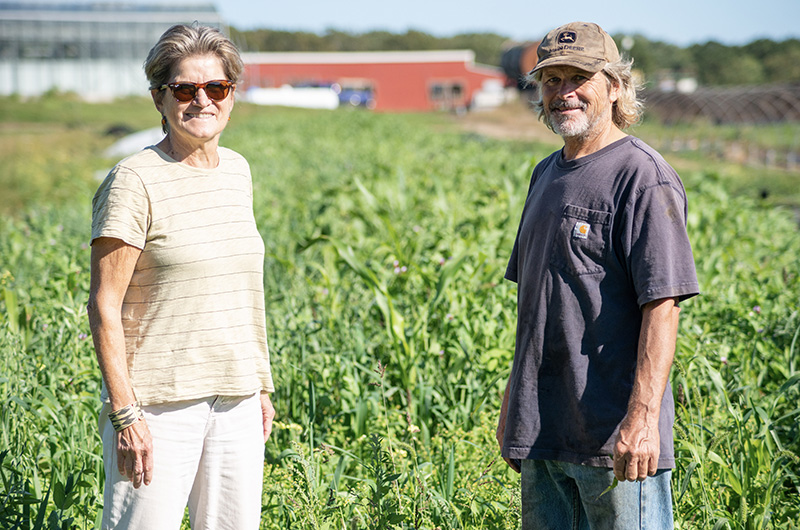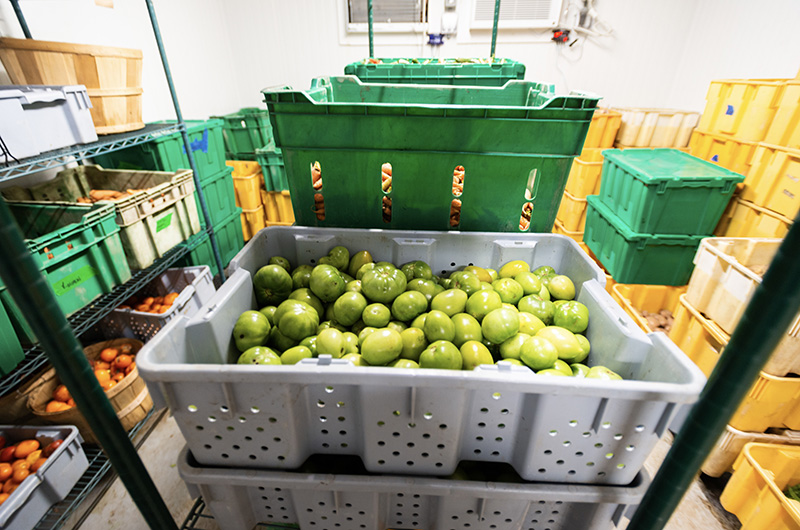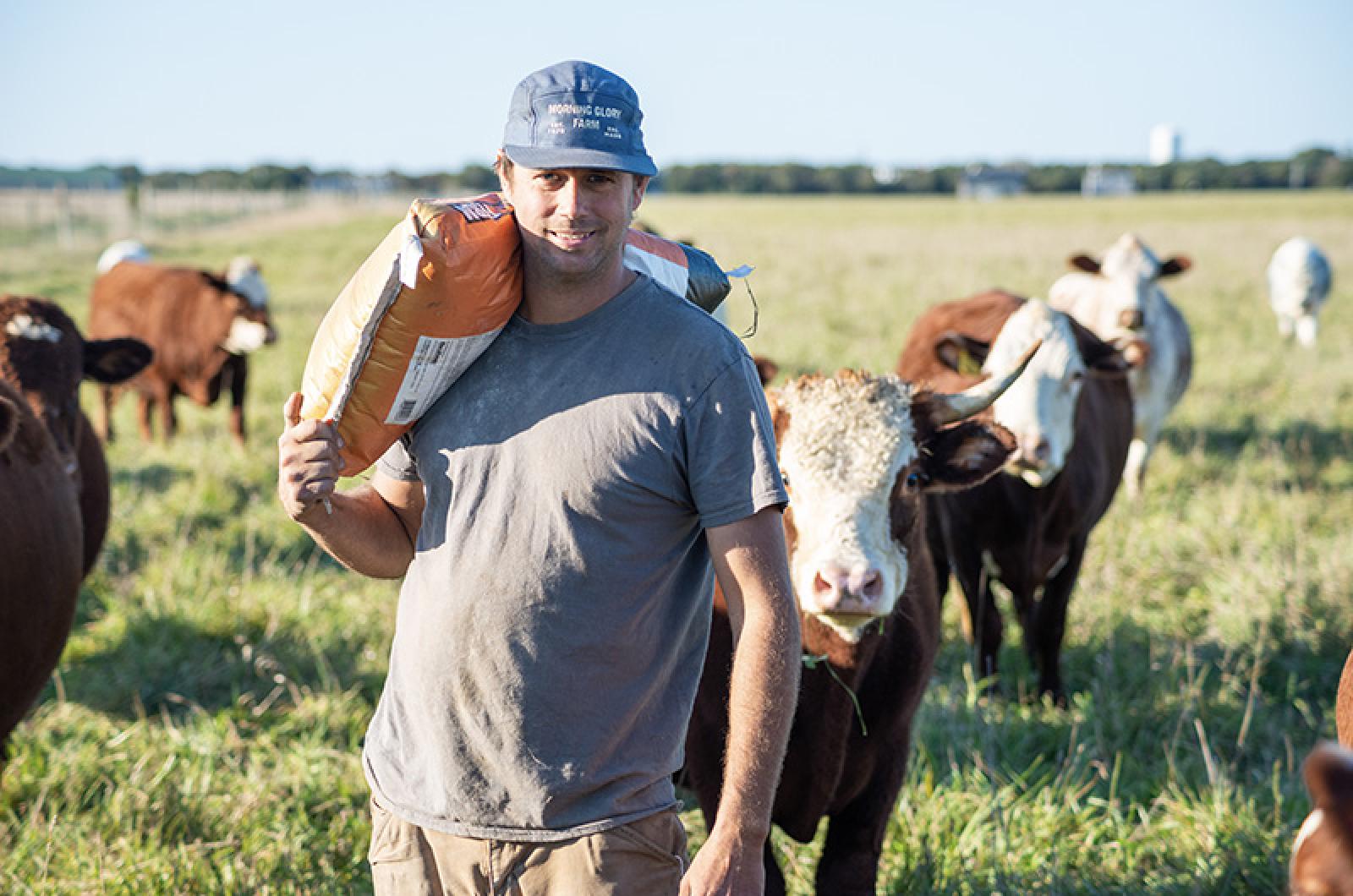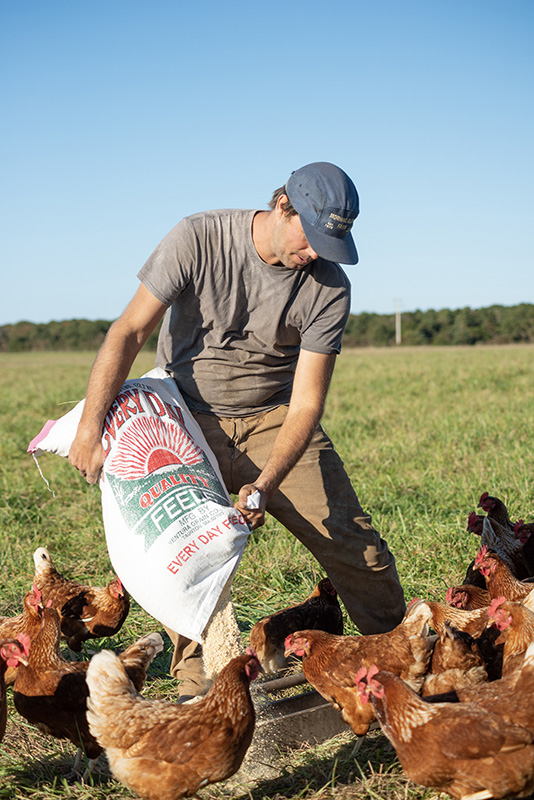Island farms are growing more food on the same amount of land, thanks to better infrastructure, attention to soil health, extending the growing season, and capturing and processing more food before it goes bad. But food grown on the Vineyard still only accounts for three to four per cent of what year-round Islanders eat.

Motivated by a higher demand for locally grown food in the last several years — and especially since the start of the pandemic — Island farmers are rethinking old norms. And it’s not just a matter of updating or adding infrastructure and equipment. The changes are more holistic, starting before the first seed is sown and ending with how, and in what form, products are reaching consumers.
The result is significant growth: Morning Glory Farm has seen a 30 per cent increase in the total sales of farm-grown food in the last three years. Grey Barn saw a 30 per cent growth in vegetable sales in 2020 and a whopping 250 per cent increase in meat sales in 2020 over 2019. In 2020, Island Grown Initiative’s (IGI) gleaning program rescued 43,000 pounds of vegetables and fruits from rot, almost doubling the 26,000 pounds in 2017. And substantially higher yields are coming from smaller farms like Beetlebung Farm, where a focus on improving the health of the soil has allowed farmers to plant at a higher density and grow higher quality vegetables.
The growth comes not on new farmland, but on land that’s been in agricultural use for decades.
Since an extensive study on self-sufficiency was published by the Martha’s Vineyard Commission in 2010, the actual number of acres farmed for food on the Island — about 930 — has not increased significantly, Morning Glory Farm CEO Simon Athearn estimates. (A new map of Island farmland created by MVC cartographer Chris Seidel similarly shows 890 acres in active grazing or crop production.)
In some cases, existing farmland that was fallow has been resurrected. At IGI’s farm hub in Vineyard Haven, the 40 acres are on a strong path back to vegetable production. IGI leases some of its land to Island farmers like Rusty Gordon of Ghost Island Farm, offers small half-acre or acre lots to young farmers just getting started, and devotes a corner of the farm to a large community garden.
And now IGI is farming 13 acres, something it wasn’t doing a few years ago as it focuses on launching and growing its food equity programs, including the mobile market, community lunch program, and a partnership with the Island Food Pantry.
Last year IGI harvested 69,000 pounds of food, not including what was gleaned from fields, according to executive director Rebecca Haag.
“And I think that’s where we’ve changed as an organization,” Ms. Haag said. “When we first started we were doing this mostly for educational purposes, and now I think we’re saying, no, we need to produce more food, because there are people on the Island who need it.
“When you’re running a nonprofit, it’s about your mission. If our mission is to feed people and we want people to be healthier, we want to bring back the soil, and we want to respond to climate change and sequester carbon, then it feels like we’re doing the right thing.”
IGI’s farming efforts focus on regenerative techniques, a goal the nonprofit established while revising its mission statement in 2018. Longtime Island farmer Andrew Woodruff was hired to lead the effort and trial regeneration methods.
“The problem is that we’ve so depleted our soils,” Ms. Haag said. “That’s what we’re really finding at the farm, that the regenerative style of growing, of not breaking up the soil, not disturbing the root system and using the compost that we’ve made has really improved the production and the nutritional value of what we’re growing.”
IGI’s goal is to distribute a third of the food they produce for free, through the Island Food Pantry, councils on aging, and other Island food equity networks. Another third ideally goes to the mobile market, to be sold at wholesale or just above wholesale prices. The last third is sold closer to market prices, through IGI’s CSA and to some restaurants and private chefs, with the hope that some of the income will help underwrite the programs that offer free food and lower-priced food sales.
But those programs would not exist without donor support, Ms. Haag said. And they are greatly needed.
“It’s bad out there,” Ms. Haag said. “People don’t realize it. We were delivering food to people living in their cars during the pandemic. And most of the Islanders who visit the food pantry on a monthly basis are working people who can’t meet their food budgets because their rents have gone way up.” Food and housing and health are all connected, she added, saying: “I think we’re on the cusp of a pretty big crisis.”
Feeding an Island
But will it be possible to feed an appreciably higher percentage of Islanders with locally grown food? Available information indicates that’s not likely.
The 2010 MVC self-sufficiency study offered an optimistic assessment, based on a range of data, of what percentage of the Island population the existing 930 acres of farmland was feeding. While the potential number was seven per cent, the study estimated the actual number was closer to four per cent.

Mr. Athearn, who is well-versed in the study, cautioned: “It’s important to realize that what they were really saying is that we could produce four or five per cent of the crops we are actually able to grow on the Vineyard during the season they grow in. In other words, during August and September, we’d have the capacity to grow four to five per cent of the amount of tomatoes consumed by the Island [year-round] population during that time.”
To predict the number of acres needed to raise the percentage, the study looked at data from the Leopold Center for Sustainable Agriculture to estimate how much food, in pounds per year, an average person eats (1,713). Then it estimated how much of that food could actually be grown on Martha’s Vineyard (about 84 per cent, with 16 per cent needing to be trucked in). Finally, it determined how much acreage per person would be needed to grow that much food (about three quarters of an acre).
With a year-round Vineyard population of 15,000 at the time the study was done in 2008-2009, that translated to a goal of 11,583 acres needed in food production compared with the existing 930, or roughly twice the size of the state forest. Nearly half of that would be needed for cattle and other animal grazing.
Looking at the nearly 30 per cent increase in population in the last 10 to 12 years (a growth the study predicted), the acreage needed to grow a majority of food for year-round Islanders climbs to 15,000 acres. And that would not include the seasonal population, which the study estimated would double those amounts.
Impossible numbers notwithstanding, Mr. Athearn and Ms. Haag both were quick to praise the work of the growing number of small farms on the Island.
“Beetlebung Farm is a perfect example of a modern regenerative farm; they’re taking great care of their soil,” Mr. Athearn said, noting that smaller farms that concentrate on building soil health can plant more intensively for bigger yields.
Home Gardens
When considering growth potential for food production, both Mr. Athearn and Ms. Haag pointed in another direction — to ordinary, backyard home gardens.
“Hands down the most important contributors to the Island food source going forward are home vegetable gardeners,” Mr. Athearn said. If everyone just grew some of the easy stuff — zucchinis, kale, beans — leaving the harder to grow stuff for farms, it would make a big difference. You could even team up with your neighbor and grow different things and trade with each other.”
The 2010 self-sufficiency report also tagged home gardeners in one of four suggested paths to significant growth in agricultural land. It suggested that two changes — a 20 per cent gain in use of prime agricultural land that is currently undeveloped combined with the creation of quarter-acre home gardens by half of all homeowners living on one acre or more — would result in upwards of 3,300 acres in agricultural use, more than triple the current number. If that had come to fruition in the past 10 years, with population growth, the Island potentially would be growing somewhere between 15 and 20 per cent of the food that year-round residents eat.
That has not come to pass.
Still, Mr. Athearn feels a dedication to customers that have asked for more locally grown food.
“We took the pandemic as a real call to action to produce more for this community,” he said.
The single biggest production upgrade for Morning Glory Farm has been the construction of a new vegetable barn behind the store, a dedicated area for washing and storing crops. “It’s been a game changer,” Mr. Athearn said. “It gave us the ability to handle much larger volumes, to have the equipment to quickly and efficiently wash, bank, package and cool food. We now have 13 vegetable washing sinks, two spray tables, a packaging table, a root washing machine, two 20-gallon salad spinners, two new walk-ins, a harvest box storage shed, and a fantastic design that really makes our jobs so much easier.” IGI’s gleaners can also use the washing area on the days they bring in vegetables from Morning Glory’s fields.
The barn — paid for partially by an MDAR agricultural improvement grant — gives the farm the ability to store some 500 bushels of crops in deep refrigeration, in addition to daily harvest refrigeration at a different humidity and temperature level. Along with storage, Morning Glory can now sell its produce year-round. Mr. Athearn said the farmstand will stay open year-round in 2022 for the first time.
In the fields, he invested in a high-density seeder and a mechanical greens harvester, which increased the volume and manageability of salad greens. Like other Island farmers, he has zeroed in on growing vegetables that do well during the shoulder seasons on the Island. Bok choy and tat soi will grow outside right through November. Beetlebung is trialing 13 varieties of radicchio this fall.
For other farmers, the biggest improvement in the last 10 years has been the addition of hoop houses which extend the growing season by several months. At Ghost Island Farm and Morning Glory, year-round greens are now a reality.
At Grey Barn, owner Eric Glasgow said they have doubled the amount of field acreage they’re devoting to vegetables, a change that’s visible in the new farmstand.
Mr. Athearn is also looking forward to the new lease at Katama Farm in Edgartown, a partnership with Grey Barn that will allow him to expand livestock and rotate animals, cover crops, hay, and crops like pumpkins.
Partnerships and cooperation among Island farmers is strong, Mr. Athearn said, and it is one more road to better productivity. This year Slough Farm, a nonprofit farm in Katama that will co-manage the educational aspect of the new Katama Farm partnership along with The FARM Institute, did a trial of growing artichokes and passed the results on to Simon.
“They have the flexibility to do a small-scale trial without worrying about failure,” he said.
Converting Produce to Meals
With a stated goal to feed people better, IGI is particularly focused on what happens to food after it comes from the fields. The gleaning initiative has been huge, but Ms. Haag has been concerned about whether groups like the elderly really benefit from the delivery of raw vegetables. She said while many folks coming through the Island Food Pantry are happy for the abundance of fresh vegetables, a single elderly person might not be inclined to wrestle a butternut squash into dinner.
“Older, single people often don’t really want to cook for themselves. And some folks are living in places with little more than a microwave or a hot plate to cook with,” Ms. Haag said. “But we’re finding that processing some of the produce into meals has been highly effective. That’s where we’re working on getting the right food to the right people at the right time.” IGI partnered with Slough Farm to produce and distribute prepared meals during the pandemic.
IGI volunteers work in the Camp Jabberwocky kitchen in the off season to process vegetables and make prepared meals. In summer, the high school kitchen is used for community lunches. IGI is currently looking at ways to increase both processing and storage ability.
One big challenge it faces is the need to update an aging greenhouse.
The behemoth that looms over the farm like the very hungry caterpillar, consuming more than its fair share of energy and depending on hydroponics to produce, was actually the catalyst for a swift pivot during the pandemic.
“We converted the back half of the greenhouse into soil beds as soon as the pandemic hit,” Ms. Haag said. The farm staff was able to grow an abundant amount of food without added heat.
While IGI works on a solar solution for the greenhouse, it’s also experimenting with a promising technology: freight farming. Thanks to Diana Barrett and The Fledgling Fund, the farm now has The Greenery, a hydroponic container farm that uses nutrient-dense water and LED lights in an efficient vertical system that promises to produce up to two and a half acres of nutritionally dense crops including greens, lettuces and herbs. Widely used in the Netherlands, freight farms are gaining more attention in the U.S. with the changes in outdoor growing conditions brought on by climate change.
While IGI and Island farms work to grow more, perhaps the biggest growth in Island-grown food can be found not on the land but in the sea. Ironically, the 2010 MVC study suggested one strategy that involved replacing most of the beef consumption with seafood, in order to more efficiently use farmland. There were only five oyster farms then; now there are more than 30, contributing more than $1 million to the economy by way of sending most of this highly nutritious and ecologically beneficial shellfish off-Island.
While native Islanders considered oysters a valued source of protein, the special occasion status awarded to the bivalve these days perhaps prevents it from making its way onto the dinner table.
That could change.









Comments (4)
Comments
Comment policy »